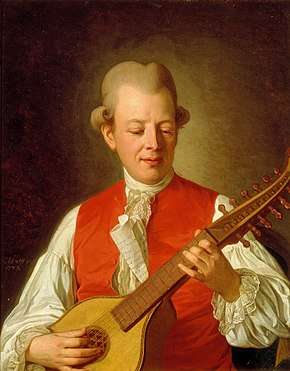Hvila vid denna källa
Hvila vid denna källa (or in modern Swedish "Vila ...", Rest by this spring), is one of the Swedish poet and performer Carl Michael Bellman's best-known and best-loved songs, from his 1790 collection, Fredman's Epistles, where it is No. 82. A pastoral, it depicts the Rococo muse Ulla Winblad, as the narrator offers a "little breakfast" of "red wine with burnet, and a newly-shot snipe" in the Stockholm countryside.
.jpg)
The epistle is subtitled "eller Oförmodade avsked, förkunnat vid Ulla Winblads frukost en sommarmorgon i det gröna. Pastoral dedicerad till Kgl. Sekreteraren Leopoldt" (or unexpected parting, proclaimed at Ulla Winblad's breakfast one summer morning in the countryside. Pastoral dedicated to the Royal Secretary Leopoldt).
Context

Carl Michael Bellman is the central figure in Swedish song, known for his 1790 Fredman's Epistles and his 1791 Fredman's Songs. He played the cittern, accompanying himself as he performed his songs at the royal court.[1]
Jean Fredman is a fictional character and the supposed narrator in Bellman's epistles and songs, based on a real watchmaker of Bellman's Stockholm.[2] The epistles paint a picture of the demimonde life of the city during the eighteenth century, where strong drink and beautiful "nymphs" like Ulla Winblad create a rococo picture of life, blending classical allusion and pastoral description with harsh reality.[1][2]
Song
The song is in 2
4 time, marked Andante.[3] It has six verses, each of 13 lines, the end of the last line being repeated after a Corno interlude. The verses have the rhyming pattern AABB-CCCB-BABAB.[4] The origin of the melody is disputed, and it may well have been one of the very few (perhaps the only one) composed by Bellman himself. Afzelius noted that the melody resembles that of Epistle 25, "Blåsen nu alla"; this would involve a change from 3
4 to 2
4 time, something Bellman is known to have been skilful at. Hildebrand argued that the melody was Bellman's; Olof Åhlström that it must have been borrowed, though the source is unknown.[5]
Reception
Epistle 82 has been recorded by Fred Åkerström, where it forms the title track of his third album of Bellman interpretations, as well as by Sven-Bertil Taube.[6] It has been translated into English by Eva Toller.[7]
The song has featured in at least 16 Swedish films from 1929 onwards.[8]
Lars Lönnroth, writing in Svenska Dagbladet, suggests that the "spring" in the Epistle was in fact not a stream in summer meadows but a fashionable spa, perhaps Djurgårsbrunn on what was in Bellman's time the edge of Stockholm.[9]
Henrik Mickos, in the 2011 Bellman lecture, discussed what the "pimpinella" of the first verse might be, concluding that salad burnet (Sanguisorba minor) was quite likely, given it was known at the time as pimpinella, and was more common in Sweden then than it is now. Mickos dismisses the possibility that it was aniseed (Pimpinella anisum), which was used to flavour brännvin but not as the song has it ("red wine and pimpinella") a wine-based punch.[10]
References
- "Carl Michael Bellmans liv och verk. En minibiografi (The Life and Works of Carl Michael Bellman. A Short Biography)" (in Swedish). The Bellman Society. Retrieved 25 April 2015.
- Britten Austin, 1967. Pages 61–93.
- Hassler and Dahl, 1989, pages 189–194
- Bellman, 1791.
- Massengale, pages 205–206
- Hassler, page 284.
- Toller, Eva. "Glimmande nymf - Epistel Nr 82". Eva Toller. Retrieved 10 March 2016.
- "Vila vid denna källa". Svensk Filmdatabas. Archived from the original on 12 March 2016. Retrieved 11 March 2016.
- Lönnroth, Lars (22 January 2002). "Ett paradis på jorden. Om den svenska kurortskulturen 1680-1880 Vattenhål för kur och kurtis" (in Swedish). Svenska Dagbladet. Retrieved 11 March 2016.
- Mickos, Henrik. "Bellmans Pimpinella" (in Swedish). Bellman Gesellschaft.de. Retrieved 11 March 2016.
Sources
- Bellman, Carl Michael (1790). Fredmans epistlar. Stockholm: By Royal Privilege.
- Britten Austin, Paul. The Life and Songs of Carl Michael Bellman: Genius of the Swedish Rococo. Allhem, Malmö American-Scandinavian Foundation, New York, 1967. ISBN 978-3-932759-00-0
- Britten Austin, Paul. Fredman's Epistles and Songs. Stockholm: Proprius, 1990 and 1999.
- Hassler, Göran; Peter Dahl (illus.) (1989). Bellman – en antologi [Bellman – an anthology]. En bok för alla. ISBN 91-7448-742-6. (contains the most popular Epistles and Songs, in Swedish, with sheet music)
- Hassler, Göran; Peter Dahl (illus.) (1989). Bellman II – en antologi [Bellman – an anthology]. En bok för alla. ISBN 91-7448-837-6.CS1 maint: multiple names: authors list (link) (contains the remaining Epistles and Songs, in Swedish, with sheet music)
- Kleveland, Åse; Svenolov Ehrén (illus.) (1984). Fredmans epistlar & sånger [The songs and epistles of Fredman]. Stockholm: Informationsförlaget. ISBN 91-7736-059-1.CS1 maint: multiple names: authors list (link) (with facsimiles of sheet music from first editions in 1790, 1791)
- Massengale, James Rhea (1979). The Musical-Poetic Method of Carl Michael Bellman. Stockholm: Almqvist & Wiksell International. ISBN 91-554-0849-4.
External links
- Text of Epistle 82
- Analysis of Epistle 82 by Lars Huldén, Bellman Society 2011
